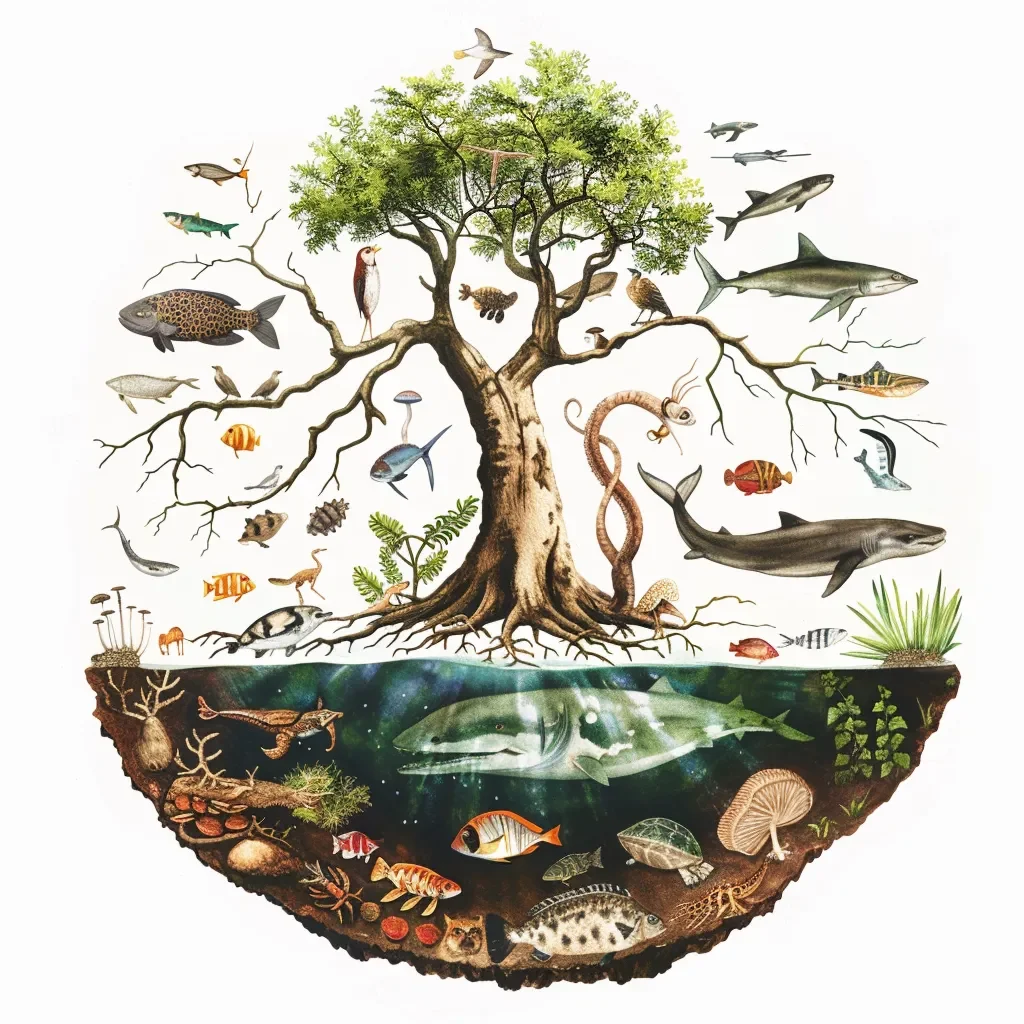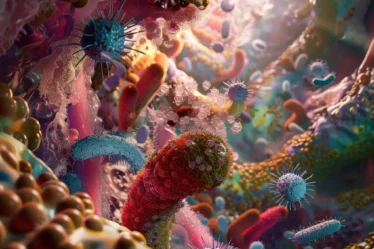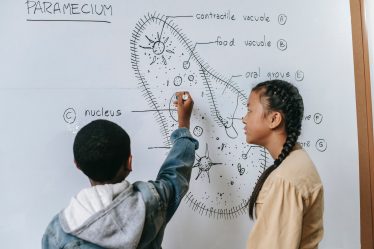
Understanding how the food chain works is like learning about nature’s menu. It’s a way to see what’s for dinner in the animal world and how everyone gets their energy.
When you get the hang of it, you’ll notice how all living things rely on each other, like pieces of a giant puzzle. Producers, consumers, and decomposers all have a particular job keeping everything running smoothly.
Read about how to learn efficiently, all about online learning, and how to write a CV.
Producers, Consumers, and Decomposers in a Food Chain: Key Takeaways
In a hurry? Don’t worry. Our critical takeaways on producers, consumers, and decomposers in a food chain will give you a quick and easy summary of the main points:
🟠 The food chain is a linear sequence showing energy flow from producers to consumers and decomposers, while the food web illustrates multiple interconnected food chains.
🟠 Producers make their food through photosynthesis, consumers eat other organisms for energy, and decomposers break down dead matter, recycling nutrients into the ecosystem.
🟠 Pollution, overfishing, and habitat destruction disrupt the balance of food chains and webs, affecting ecosystem nutrient cycling and energy flow.
If you find food chains and webs challenging, don’t worry! Personalized tutoring or interactive biology lessons make these concepts more straightforward. Explore more biology topics and broaden your knowledge with our free Biology blogs.
Food Chain Overview: Producers, Consumers, Decomposers
A food chain shows who eats what in nature. It’s a simple way to see how energy and nutrients move through an ecosystem.
At the base of the food chain are producers, like plants, that make their food through photosynthesis. They convert sunlight into energy that becomes the foundation for all other life in the ecosystem.
Next are the consumers. These organisms can’t make food and must eat other organisms for energy. We divide consumers into different levels. Primary consumers are herbivores that eat plants. Secondary consumers are carnivores that eat herbivores. Tertiary consumers are top predators that eat both primary and secondary consumers.
Finally, there are decomposers. These organisms, like fungi and bacteria, break down dead plants and animals. This process returns essential nutrients to the soil, making them available for producers to use again.
A food web is more complex than a food chain. It shows how different food chains in an ecosystem are connected. While a food chain follows a single path, a food web shows multiple pathways through which energy and nutrients flow.
Learning about the food chain helps you understand how nature works. It shows how all living things are linked. Producers, consumers, and decomposers each have a job to do. They work together to keep the ecosystem balanced and healthy.
Producers: The Foundation of the Food Chain
Producers form the base of the food chain. They are essential because they generate the energy that supports all other life forms in an ecosystem. Without producers, consumers wouldn’t have the energy they need to survive.
Autotrophs and Their Role
Autotrophs, or producers, are organisms that can make their food. They do this through photosynthesis, converting sunlight, water, and carbon dioxide into glucose and oxygen. Plants are the most common autotrophs, but algae and some bacteria also perform photosynthesis. These organisms are vital because they provide the primary energy source for all other organisms in the ecosystem.
Consumers: The Various Levels
Consumers are organisms that cannot produce food and must eat other organisms to obtain energy. They are categorized based on their diet and position in the food chain.
Primary Consumers: Herbivores
Primary consumers are herbivores that eat plants directly. They are the first level of consumers in the food chain. Examples of primary consumers include rabbits, deer, and caterpillars. These animals play a crucial role in transferring energy from producers to higher levels in the food chain.
Secondary Consumers: Carnivores and Omnivores
Secondary consumers are animals that eat primary consumers. They can be either carnivores (meat-eaters) or omnivores (animals that eat both plants and animals). Examples of secondary consumers include snakes, frogs, and some birds. These organisms help control the population of primary consumers, maintaining balance within the ecosystem.
Tertiary Consumers: Apex Predators
Tertiary consumers are the top predators in a food chain. They eat primary and secondary consumers and have few or no natural predators. Examples of tertiary consumers include eagles, wolves, and sharks. As apex predators, they help regulate the populations of other consumers, ensuring a healthy balance within their ecosystems.
Finding concepts like producers and comsumers intricate? A biology tutor can offer personalized lessons that cater to your learning style, making complex biological processes accessible and engaging.
Food Chain is a Simple Pathway
A food chain represents an ecosystem’s straightforward, linear sequence of who eats whom. It begins with the producers and moves up through various consumer levels. This simple pathway shows how energy is transferred from one organism to another.
Food Chain has a Linear Energy Flow
In a food chain, energy flows in a single direction. It starts with producers, such as plants, which convert sunlight into energy through photosynthesis. This energy is stored in the plants and passed on to the next level, the primary consumers, when herbivores eat the plants. Primary consumers might include animals like rabbits, deer, or caterpillars.
The next level consists of secondary consumers, carnivores, or omnivores that eat herbivores. Secondary consumers include snakes, frogs, and some birds. These organisms gain energy by consuming primary consumers.
The tertiary consumers or apex predators are at the top of the food chain. These are the animals that eat both primary and secondary consumers and have few or no natural predators themselves. Examples include eagles, wolves, and sharks. Each step in this chain is known as a trophic level, and energy diminishes as it moves up the chain. Typically, only about 10% of the energy at one trophic level is transferred to the next level, with the rest lost as heat.
Food Web is a Complex Network
A food web provides a more accurate and intricate representation of how energy and nutrients move through an ecosystem. Unlike a food chain, which follows a single pathway, a food web consists of multiple interconnected food chains.
Interconnected Food Chains
In a food web, many organisms have varied diets and can occupy different positions in multiple food chains. For example, a hawk might eat rabbits, snakes, and small birds, while those prey animals may consume various plants or insects. This network of interdependencies creates a complex web where the impact of one species can affect many others. This interconnectedness increases the stability of the ecosystem, as it provides alternative food sources and helps distribute energy more evenly.
For instance, if the population of rabbits decreases, predators like hawks might turn to other prey like snakes or small birds. This flexibility ensures that the energy flow within the ecosystem is maintained, even if certain populations fluctuate.
Comparing Food Chains and Food Webs
| Feature | Food Chain | Food Web |
| Pathway | Simple, linear | Complex, interconnected |
| Representation of Ecosystem | Limited | Comprehensive |
| Energy Flow | One direction | Multiple directions |
| Stability | Less stable | More stable |
| Examples | Grass → Rabbit → Snake → Hawk | Grass → Rabbit → Snake; Grass → Deer → Wolf |
Food chains and food webs help us understand how ecosystems work. A food chain gives a clear, simple view of energy flow, while a food web shows the complex interactions that sustain life.
Decomposers are Recyclers in the Food Chain
Decomposers play a crucial role in ecosystems by breaking down dead organic matter and recycling nutrients into the soil. Without decomposers, dead plants and animals would accumulate, and nutrients would remain locked in waste and dead matter.
Decomposers Break Down Organic Matter
Decomposers break down organic matter through chemical processes. They secrete enzymes that decompose complex organic compounds into simpler substances. This process releases nutrients like nitrogen, phosphorus, and potassium, making them available for use by plants and other producers. Decomposition involves several stages, starting with the breakdown of soft tissues and eventually leading to the mineralization of hard structures like bones and shells.
Types of Decomposers
- Bacteria are microscopic organisms that decompose a wide range of organic materials. They are particularly effective in breaking down proteins and carbohydrates.
- Fungi, including molds and mushrooms, decompose complex organic substances such as lignin and cellulose found in wood and plant fibers.
- Detritivores are organisms like earthworms, beetles, and millipedes that physically break down organic matter into smaller pieces, making it more accessible for bacteria and fungi.
- Actinomycetes are a group of bacteria with characteristics similar to fungi. They are crucial in breaking down tough plant materials like cellulose and chitin.
Decomposers in the Ecosystems: Nutrient Cycling
Decomposers are essential for nutrient cycling, a process that maintains the balance of nutrients in the ecosystem. By breaking down organic matter, decomposers convert nutrients into forms that plants can absorb. This process enriches the soil, improving its fertility and structure. Healthy soil supports robust plant growth, supporting herbivores, and higher trophic levels.
Decomposers also help control disease by breaking down dead and decaying matter that could harbor pathogens. By recycling organic material, decomposers contribute to the carbon cycle, helping regulate the Earth’s climate by controlling the amount of carbon stored in biomass versus that released into the atmosphere.
Decomposers keep ecosystems healthy and productive by breaking down dead matter and recycling nutrients. They ensure nutrients are always available, helping maintain balance and resilience in natural environments.
Human Impact on the Food Chain
Pollution and Its Effects
Human activities significantly impact the food chain, mainly through pollution. Pollutants like chemicals, plastics, and heavy metals enter ecosystems and disrupt natural processes. Pollution harms organisms at all trophic levels. Pesticides kill pests and beneficial insects, while chemical pollutants bioaccumulate in organisms, leading to biomagnification. Top predators, including humans, can suffer severe health effects from these toxins. Pollution also degrades habitats, making survival difficult for many species.
Overfishing and Habitat Destruction
Overfishing and habitat destruction are major threats to marine food chains. Overfishing depletes vital fish species, disrupting aquatic ecosystems. This reduction impacts predators and causes imbalances in the ecosystem. Habitat destruction, like coral reef damage and mangrove deforestation, reduces biodiversity and the resilience of marine food chains.
How to Protect the Food Chain
- Regulate pollution: Implement stricter controls on industrial discharges and agricultural runoff.
- Practice sustainable fishing: Enforce quotas and protect breeding grounds.
- Restore habitats: Rehabilitate damaged ecosystems.
- Establish protected areas: Limit fishing and other activities in marine protected areas (MPAs).
- Raise public awareness: Educate the public about sustainable practices and biodiversity.
By mitigating human impacts, we can help preserve the balance of food chains and maintain healthy ecosystems.
How to Learn About the Food Chain and Food Web with Tutoring
We’ve learned about the food chain and food web, covering producers, consumers, and decomposers. We discussed how energy flows through these levels and how nutrient cycling supports ecosystems.
To deepen your knowledge, consider taking tutoring sessions or private lessons. A private teacher can explain complex topics clearly. Tutoring can make your learning more effective and engaging, helping you better understand food chains and webs.
If you’re searching for a biology tutor, a quick search for “biology tutor Liverpool” or “biology teacher Birmingham” on platforms like meet’n’learn can connect you with the ideal private teacher for your educational journey.
Those preferring group learning settings can find biology classes in their area by looking up “biology classes Leeds” or “biology lessons London” online, leading to community colleges or educational workshops.
Food Chains and Food Webs: Frequently Asked Questions
1. What is the food chain?
A food chain shows the sequence of who eats whom in nature.
2. What are producers?
Producers are organisms like plants that make their food through photosynthesis.
3. Who are primary consumers?
Primary consumers are herbivores that eat plants.
4. What role do secondary consumers play?
Secondary consumers are carnivores or omnivores that eat herbivores.
5. Who are tertiary consumers?
Tertiary consumers are apex predators that eat primary and secondary consumers.
6. What is a food web?
A food web is a complex network of interconnected food chains.
7. Why are decomposers important?
Decomposers break down dead organic matter, recycling nutrients back into the ecosystem.
8. How does pollution affect the food chain?
Pollution harms organisms and disrupts natural processes in the food chain.
References:
1. Britannica
2. National Geographic
3. Wikipedia



